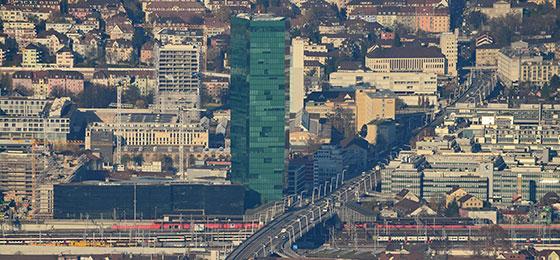Optimising transport management: anonymous individual mobility traces

Each day, smartphone users generate an large volume of time-stamped location data. Cities could use this anonymised data to optimise their transport systems. The aim of this project is to develop a mobility pricing approach as a contribution to these optimisations.
Portrait / project description (completed research project)
The collaboration with a network operator gives the project access to four exceptionally detailed data sets:
- An aggregated data set on long-distance travel behaviour patterns allowing a precise estimate of trips over 50 kilometres for the first time;
- Anonymised 50,000 person-days permitting the development of new algorithms to identify daily behaviour patterns;
- Anonymised 10,000 person-weeks facilitating the estimation of detailed traffic behaviour models;
- Aggregated, average hourly demand by month from each Swiss commune to every other.
Work will comply with data-protection regulations and aims to improve and calibrate the Switzerland model, which we will construct using the individual-based software MATSim.
Background
Many city road and rail trips face bottlenecks during peak periods, whereas for the remainder of the time infrastructure utilisation is low. Smartphone data provides a comprehensive picture of usage of a city. Drawing on anonymised data from network operator subscribers, this project aims to refine an individual-based model of Switzerland – and to develop an approach with dynamic transport prices that is capable of supporting Swiss transport policy.
Aim
By way of example, we will develop new modelling methods based on anonymised mobile phone data sets. The objective behind modelling these electronic traces is to enhance current individual-based simulations – and explore and optimise example scenarios for the possibilities, costs and limitations of a Swiss mobility pricing approach.
Relevance/application
Transport models can be constructed faster and calibrated more reliably using large volumes of data. The models will serve to improve traffic system control and thus help to smooth infrastructure peak loads. The data-optimised MATSim model of Switzerland and the mobility pricing findings have the potential to make a key contribution to maximising transport system efficiency, which in turn will enhance the well-being of everyone.
Results
- Using data extracted from GSM traces, the accuracy of reporting of long distance travel in the Swiss Mobility and Transport Microcensus (MTMC) was investigated, based on previous research which indicated an under-reporting of trips in travel diary based surveys. An analysis did not find such evidence in the Swiss context; an important result considering the importance of the MTMC for transport research in Switzerland.
- Work analysing the derailment at Lucerne Station that occurred March 2017 had to be paused due to the Covid-19 Pandemic. Nonetheless, the R package mixl developed for choice modelling in this (and a wider) context has been publicly released and applied on a range of modelling projects both in Switzerland and internationally.
- An approach for creating a policy-sensitive transport simulation scenario based on mobile phone records instead of travel surveys. Applied to create a prototype for the metropolitan area of Zurich. This region is particularly suitable because multiple MATSim scenarios have been created for this region with a high standard of scenario validation, such that scenario-to-scenario comparisons can be carried out. The cell-phone network operator provided mobile-phone-based origin-destination matrices for Switzerland within the context of this package.
- Bayesian optimization (BO) methods developed by the Learning & Adaptive Systems Group, led by Prof. Andreas Krause at ETH Zurich, resulted in advances in the calibration of large transport models. The application of the proposed methods was extensively studied on MATSim as well as its modification eqasim and covers different scales of transportation scenarios.
- With the shift towards a more varied transport landscape, better transport models are more important than ever for understanding how new technological developments driven by digitalisation will affect our lives in the future. The progress made in this project on automated scenario generation and tools for behavioural analysis have contributed in the progress towards this goal.
Original title
Big data transport models: The example of road pricing
